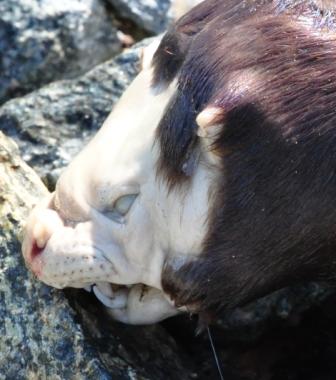
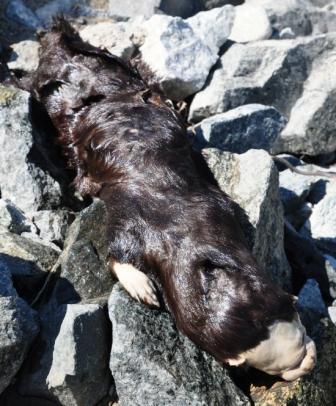
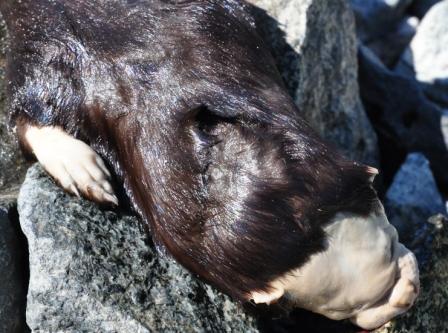
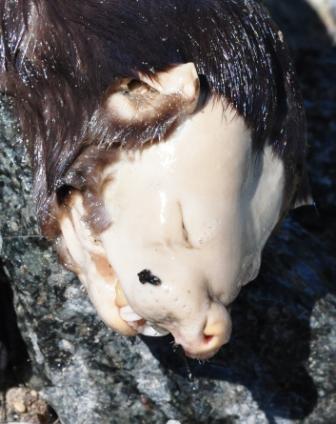
May 20, 2010
What is it?




The new photos of the recently discovered dead animal found in a northern Ontario waterway has the potential to be another “Montauk Monster” situation. Local media in Canada is already going bananas with the beast story.
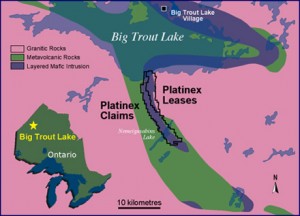
Where is all of this happening? The strange dead body was pulled from a local creek in early May 2010 at Kitchenuhmaykoosib Inninuwug (Oji-Cree: ᑭᐦᒋᓇᒣᑯᐦᓯᑊ ᐃᓂᓂᐧᐊᐠ (Gichi-namegosib ininiwag); unpointed: ᑭᒋᓇᒣᑯᓯᑊ ᐃᓂᓂᐧᐊᐠ or ᑭᐦᒋᓇᒣᑯᐦᓯᐱᐎᓂᓂᐗᐠ (Gichi-namegosibiwininiwag); unpointed: ᑭᒋᓇᒣᑯᓯᐱᐎᓂᓂᐗᐠ). The location is also known as Big Trout Lake First Nation or KI for short, and it is a First Nations community in northwestern Ontario. The community is about 580 km (360 mi) north of Thunder Bay, Ontario.

The backstory of the Bald Beast of KI is that a local dog named Sam, with its two owners, women nurses, found the beast floating face down in the creek, and they pulled it from the water. They then took photographs of the less-than-foot long, 30-centimetre-long dead creature.
Images (as above) of the furry, bald-faced creature were then placed on the official website of the Big Trout Lake community and have since caused an uproar of speculation on the Internet.
Of course, media outlets have already mentioned the Canadian Ogopogo, Scotland’s Loch Ness Monster, and the Latino Chupacabras.
But more realistic considerations have talked about it being a known species, such as a bear cub (Ursus americanus) or other animals. Even the mundane looks strange without hair.
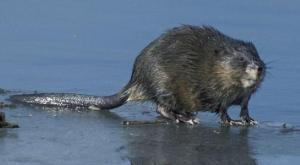
However, with the structure of the head, the description of a “rat-like” tail, and the 11-inch-length, one suggestion is that it might be a semi-aquatic rodent, the muskrat (Ondatra zibethicus). Two views of muskrat skulls are below.
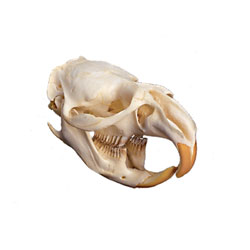
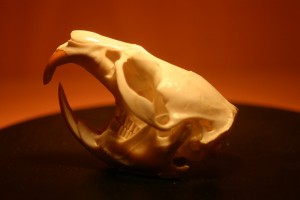
The other top candidate is that of the North American river otter (Lontra canadensis). Yes, it could simply be a dead river otter.
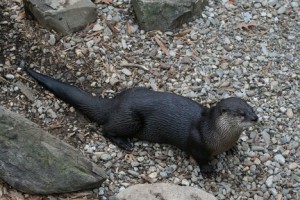
Two views of river otter skulls are below.
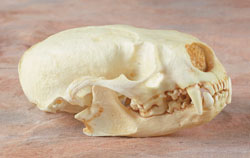
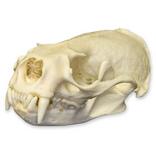
Thanks for the heads up from Peter Leronowich.
UPDATE.
Media attention: The Toronto Star ran a story on Friday, May 21, 2010, in which they mentioned this posting in Cryptomundo. They also picked one comment out to highlight. The conclusion of their article reads:
Cryptomundo.com, a site devoted to “elusive and rare animals,” has done an analysis of various small animals’ skulls, with the muskrat seeming a close match—although the nasty teeth were judged un-muskrat-like.
Others speculate it may be the mythical Ogopogo, the Chupacabra or some other marine monster, like the Loch Ness Monster.
“But more realistic considerations have talked about it being a known species, such as a bear cub (Ursus americanus) or other animals. Even the mundane looks strange without hair,” Loren Coleman at Cryptomundo said.
“The other top candidate is that of the North American river otter (Lontra canadensis).”
A New Zealand zoologist examined the teeth, whiskers and paws and decided:
“I think this is just another variation of an ordinary creature sculpted by the action of decomposition by water, as I demonstrated last year with the Gisbourne New Zealand Monster that was actually a drowned Opossum.”
CTV carried extensive coverage of this story on Friday, as well, and it spread throughout the mainstream press as the day progressed.
About Loren Coleman
Loren Coleman is one of the world’s leading cryptozoologists, some say “the” leading living cryptozoologist. Certainly, he is acknowledged as the current living American researcher and writer who has most popularized cryptozoology in the late 20th and early 21st centuries.
Starting his fieldwork and investigations in 1960, after traveling and trekking extensively in pursuit of cryptozoological mysteries, Coleman began writing to share his experiences in 1969. An honorary member of Ivan T. Sanderson’s Society for the Investigation of the Unexplained in the 1970s, Coleman has been bestowed with similar honorary memberships of the North Idaho College Cryptozoology Club in 1983, and in subsequent years, that of the British Columbia Scientific Cryptozoology Club, CryptoSafari International, and other international organizations. He was also a Life Member and Benefactor of the International Society of Cryptozoology (now-defunct).
Loren Coleman’s daily blog, as a member of the Cryptomundo Team, served as an ongoing avenue of communication for the ever-growing body of cryptozoo news from 2005 through 2013. He returned as an infrequent contributor beginning Halloween week of 2015.
Coleman is the founder in 2003, and current director of the International Cryptozoology Museum in Portland, Maine.
Filed under Breaking News, CryptoZoo News, Media Appearances, Ogopogo, Photos, Weird Animal News